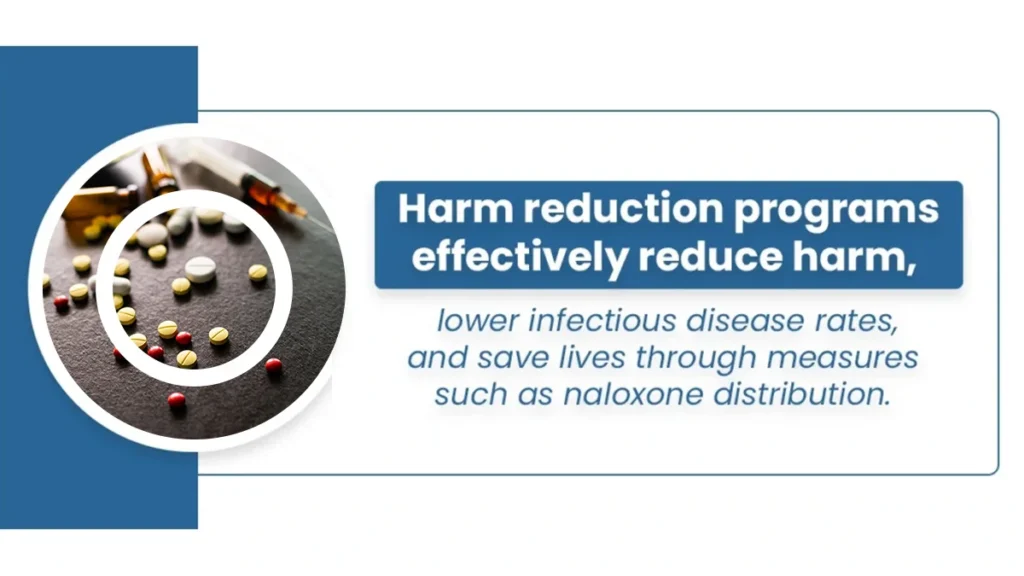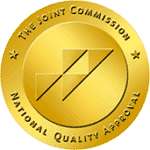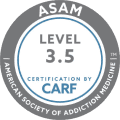In addressing substance use, harm reduction strategies shine as beacons of hope. These strategies present practical and compassionate approaches to reduce the negative results linked with substance use. Rather than abruptly enforcing abstinence, harm reduction acknowledges that some individuals may continue to use substances.
It focuses on reducing the risks and harms that can emerge from such behaviors and supports individuals in their substance abuse recovery process. Through various methods and tools, harm reduction aims to keep individuals safer and healthier, fostering an environment where they can make informed choices at their own pace.
In this article, we will delve into the world of harm reduction strategies, understanding their significance and how they contribute to the overall well-being of those dealing with substance use challenges.

Key Takeaways
Harm reduction strategies prioritize safety and well-being over judgment in addressing substance use challenges. Here you will get to know:
- These strategies encompass diverse approaches like needle and syringe programs, Opioid Agonist Therapy, and safe injection facilities.
- Harm reduction programs effectively reduce harm, lower infectious disease rates, and save lives through measures such as naloxone distribution.
- By meeting individuals where they are and fostering trust, harm reduction supports positive changes for individuals, families, and communities.
- Harm reduction shifts the focus from moral failings to complex health issues, offering practical and compassionate solutions for substance use-related problems.
Choose The Haven Detox-New England today and take the first step towards a healthier and brighter future. Admit to our program by contacting us at (844) 933-4145 and embark on a journey of healing and transformation.
Prevalence of Drug Abuse
Drug abuse’s far-reaching impact underscores the urgent need for effective solutions. Globally, more than 16 million people have opioid use disorders, with over 2.1 million cases in the United States alone. Heartbreakingly, opioids claim the lives of over 120,000 individuals annually worldwide.
In the United States, the numbers tell a sobering tale. In 2021, 61.2 million people aged 12 or older, constituting 21.9 percent of the population, engaged in illicit drug use within the past year. Chief among these substances is marijuana, used by a whopping 52.5 million individuals.
These figures highlight the urgency of adopting harm reduction strategies, which seek to alleviate the harm associated with substance use while acknowledging the widespread nature of the problem and aiming to prevent drug abuse. Such strategies hold promise as compassionate, pragmatic approaches to positively impacting the lives of those affected by drug misuse.
Principles of Harm Reduction
Harm reduction strategies stem from empathetic principles prioritizing the well-being of individuals struggling with substance use disorders. Central to this approach is acknowledging that drug use, to varying extents, is a reality for many people. Rather than stigmatizing or isolating those affected, harm reduction seeks to reduce negative consequences associated with substance use.
These approaches operate on various fronts. They extend a helping hand to ensure safe drug use practices, including opioid treatment, through supervised injection sites and syringe services programs. Moreover, harm reduction services promote access to vital health resources like drug treatment and medical care. Naloxone distribution, for instance, equips drug users and those around them to counter opioid overdoses effectively.
Crucially, harm reduction interventions transcend individual actions, reaching into public health policy. By providing accurate information and support, harm reduction strategies save lives and foster a society where empathy, health, and well-being precede judgment.
Types of Harm Reduction Strategies
Embracing a harm reduction approach involves a comprehensive set of practical strategies to minimize the negative consequences of substance use and promote individuals’ overall health and well-being. These strategies span various community and healthcare engagement aspects, each contributing to a safer and more compassionate environment.
Needle and Syringe Programs
One of the earliest and most recognized harm reduction initiatives, needle and syringe programs (NSPs) provide sterile injecting equipment to individuals who use drugs intravenously. NSPs reduce the risk of infectious diseases like HIV and viral hepatitis, benefiting individuals and the broader community.
These programs also offer critical support services, connecting participants with social services, addiction treatment options, and healthcare resources.
Opioid Agonist Therapy
For individuals struggling with opioid use disorder, Opioid Agonist Therapy (OAT) has shown promising results. Medications like methadone and buprenorphine help minimize cravings and withdrawal symptoms, facilitating a path toward recovery.
OAT not only addresses the health risks associated with opioid use but also lessens the risk of overdose and promotes stability and positive changes in the lives of those affected.
Overdose Prevention and Response
Addressing the alarming rise in opioid-related deaths, overdose prevention and response strategies have gained prominence. Harm reduction providers, peers, and medical staff are trained to administer naloxone, a life-saving medication that can reverse opioid overdoses.
Equipping both individuals who use substances and others in their community with naloxone has been endorsed by organizations like the World Health Organization as a vital step in curbing overdose deaths.
Safe Injection Facilities
Safe injection facilities (SIFs) offer supervised spaces for individuals to consume drugs under medical supervision. Beyond reducing the risk of overdose, SIFs provide opportunities for engagement with healthcare professionals, offering health services and pathways to treatment.
These facilities also mitigate the harm caused by public drug consumption, promoting a safer community environment.
Drug Checking Services
Recognizing that individuals may not cease substance use immediately, drug-checking services have emerged as harm reduction organizations’ response. These services allow users to check the composition of their drugs, identifying potential contaminants or high potency.
Drug-checking services aim to minimize the risk of adverse reactions and save lives by empowering users with information about what they consume.
Lastly, the diverse harm reduction strategies reflect a commitment to individual choice, community well-being, and social justice. These approaches transcend conventional notions of drug addiction treatment, aligning with the evolving understanding of substance use disorders as complex health issues rather than mere moral failings.
As research, success rates, and supportive policies continue to underscore the effectiveness of harm reduction, their integration into broader health promotion and recovery support becomes paramount, offering a pathway toward positive change in the face of substance-related challenges.
Effectiveness of Harm Reduction Programs
Harm reduction programs have shown value in improving health and reducing harm among individuals facing substance use challenges. Studies indicate that these strategies make a significant impact. For instance, needle and syringe programs (NSPs) have been linked to lower rates of infectious diseases. Opioid Agonist Therapy (OAT) has helped reduce drug use and enhance overall well-being. Overdose prevention efforts, including naloxone distribution, have saved lives and reduced overdose deaths.
Safe injection facilities (SIFs) provide a safer environment for drug use and have been associated with decreased public drug consumption and related harms. Drug-checking services contribute to user safety by identifying dangerous substances. These programs collectively emphasize harm reduction’s practicality and effectiveness.
Harm reduction programs are pivotal in supporting those dealing with substance use issues by prioritizing health, safety, and individual needs. They succeed in meeting people where they are, fostering trust, and making positive changes attainable for individuals, families, and communities.
The Goal of Harm Reduction
Harm reduction programs have shown value in improving health and reducing harm among individuals facing substance use challenges. Studies indicate that these strategies make a significant impact. For instance, needle and syringe programs (NSPs) have been linked to lower rates of infectious diseases. Opioid Agonist Therapy (OAT) has helped reduce drug use and enhance overall well-being. Overdose prevention efforts, including naloxone distribution, have saved lives and reduced overdose deaths.
Safe injection facilities (SIFs) provide a safer environment for drug use and have been associated with decreased public drug consumption and related harms. Drug-checking services contribute to user safety by identifying dangerous substances. These programs collectively emphasize harm reduction’s practicality and effectiveness.
Harm reduction programs are pivotal in supporting those dealing with substance use issues by prioritizing health, safety, and individual needs. They succeed in meeting people where they are, fostering trust, and making positive changes attainable for individuals, families, and communities.
Frequently Asked Questions (FAQ)
What strategies are used to prevent substance use and abuse?
Various strategies are employed to prevent substance use and abuse. These include:
Educational campaigns.
Community programs.
Early intervention efforts.
Stricter regulations on sales.
The promotion of healthy coping mechanisms.
By addressing risk factors and providing support, these strategies aim to reduce the initiation and escalation of substance use, ultimately fostering healthier lifestyles.
What are the three levels of prevention for substance abuse?
Substance abuse prevention operates on three levels: primary, secondary, and tertiary.
Primary prevention targets everyone, aiming to stop substance use before it starts through education and awareness. Secondary prevention focuses on at-risk individuals, offering early intervention and support to prevent further escalation. The third level, tertiary prevention, supports those already affected, providing treatment, recovery, and reducing the harm associated with substance abuse.
These levels work together to create a comprehensive approach to addressing substance abuse across different stages.
What are the primary objectives of harm reduction strategies for substance use?
The primary objectives of harm reduction strategies for substance use are to minimize the adverse effects and risks associated with drug use while recognizing the reality of its presence. These strategies aim to enhance individual and community well-being by offering safer usage practices, access to healthcare services, and support for healthier choices.
By prioritizing safety and health over judgment, harm reduction strategies seek to reduce harm, prevent overdose, limit disease transmission, and provide pathways to treatment and recovery, ultimately promoting a more compassionate and practical approach to addressing substance use challenges.
Embrace Sober Life at The Haven Detox-New England
Harm reduction can help you navigate safer substance use, but can you imagine a life after breaking free from the cycle of dependency? At The Haven Detox-New England, we aim to let you achieve the sobriety you need. Our team strives to be more than just a facility; our goal is to serve as a bridge to long-lasting recovery.
Our detoxification program offers a safe and nurturing start, laying the foundation for lasting sobriety from substance use. Experience our dual diagnosis treatment, where we understand and address your mental health and addiction struggles. Moreover, our treatments are uniquely tailored to guide you from the grasp of substances like cocaine, meth, and opioids.Don’t wait. Step forward by contacting us at (844) 933-4145.



